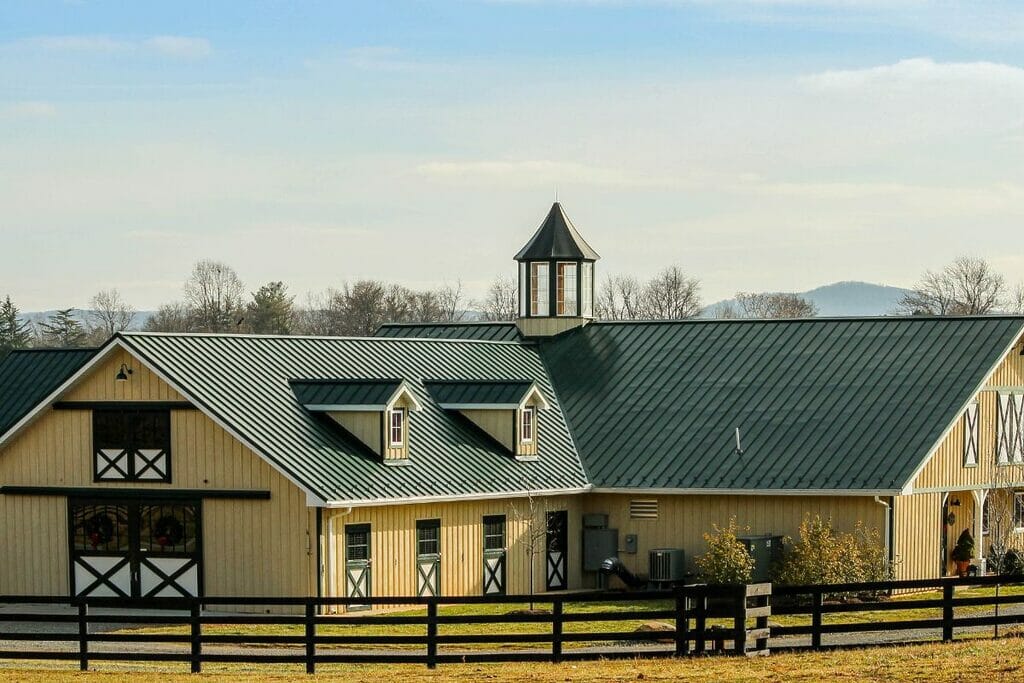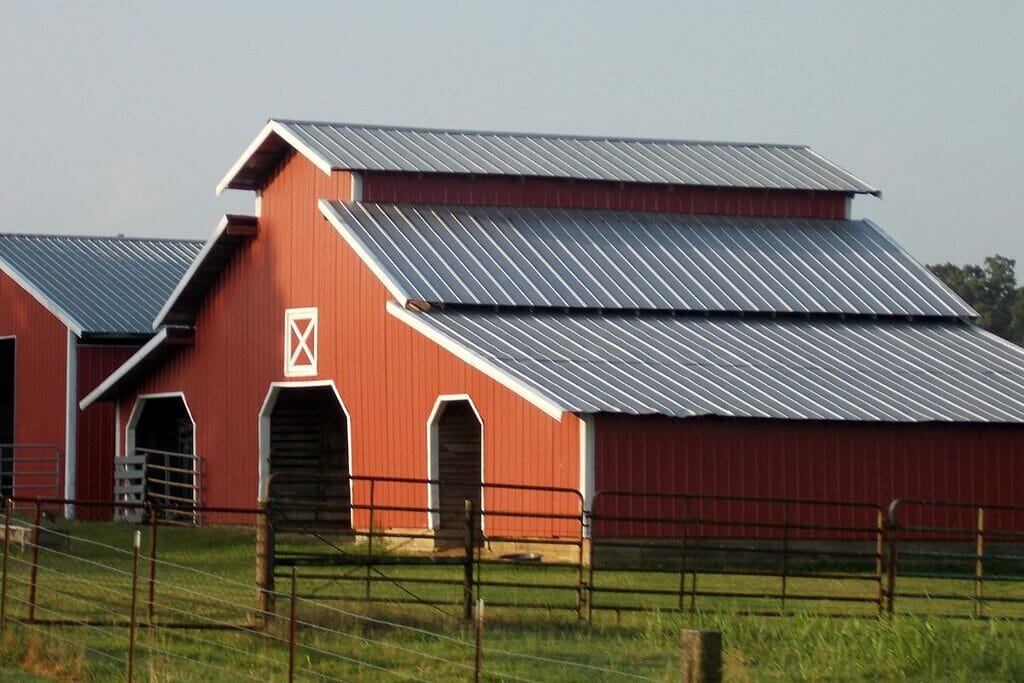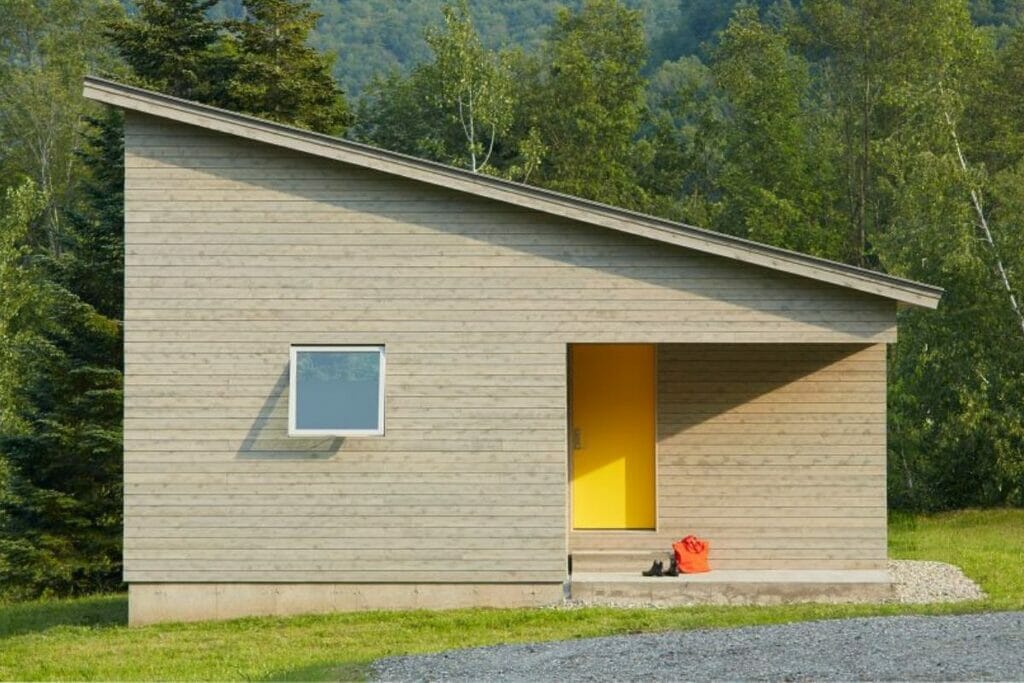If you’re on a mission to build the perfect pole barn, don’t get stuck with the wrong roof. Your roof choice can change everything! There are plenty of types of barn roofs to explore, and you must build one that aligns with your storage requirements and local climate.
As a roofing expert at Excel Renovation, I’m here to help you understand your roofing options so that you can make an informed decision and enjoy the benefits of a sturdy, long-lasting pole barn roof.
Pole Barn Roof Designs: Weighing the Pros & Cons
Before we dive into the nitty-gritty of pole barn roofs, let’s take a moment to understand the basics. Pole barns, also known as post-frame buildings, are simple and efficient structures. They rest on posts set into the ground, and the type of roof you choose plays a vital role in determining the building’s functionality, durability, and overall appearance.
The Homey Gable Roof

First up, we have the gable roof, a familiar sight on many homes and pole barns. With its two sloping sides meeting at the ridge, it forms a neat triangular shape on either end of the building. Let’s take a look at its pros and cons.
Pros:
- It provides excellent water drainage, thanks to its sloping design
- You’ll enjoy more headspace and vertical storage potential
- It’s a budget-friendly and straightforward option to construct
Cons:
- For larger pole barns, it might limit the width available
- In areas with strong winds, it could be more susceptible to damage
The Classic Gambrel Roof

Now, let’s talk about the charming gambrel roof, often reminiscent of classic barns. With its two different slopes, this roof type offers a unique aesthetic. But it comes with its own set of pros and cons.
Pros:
- You get more usable space in the attic or loft area
- Who can resist its rustic appeal? It adds a touch of classic charm
- It has better wind resistance compared to gable roofs
Cons:
- The construction is a bit more complicated, so you’ll need skilled contractors
- You might have reduced headroom along the sidewalls
The Functional Monitor Roof

Next on the list is the monitor roof, a popular choice for agricultural and commercial pole barns. It features a raised center section with shed roofs on each side, and it has its own unique perks and limitations.
Pros:
- Expect ample natural light flooding in, making it ideal for workshops and storage
- These roofs provide excellent ventilation, perfect for livestock and hay storage
- Need a larger building? This design is suitable for expanded widths
Cons:
- Given the complex design, construction costs might be slightly higher
- You’ll want to keep an eye on maintenance, as it has additional seams and joints
The Practical Single-Slope Roof

Now, let’s talk about the practical single-slope roof, also known as a shed roof, characterized by its simplicity. With a single slope from one end to the other, it’s a favorite among modern pole barn designs.
Pros:
- Easy on the wallet and simple to construct – a win-win!
- It directs water runoff to one side for easy drainage
- It has a clean and contemporary look you’ll love
Cons:
- Shed roofs have limited vertical space on one side
- If you’re storing tall equipment, you might find the storage potential reduced with a shed roof
The Versatile Hip Roof
A stable and timeless choice, a hip roof has four sloping sides coming together at a ridge. It’s a common choice, but let’s weigh its benefits and shortcomings for a pole barn structure.
Pros:
- This roof performs well in areas with high winds
- It has a classic charm that’s always a hit
- You’ll have extra living or storage space
Cons:
- It’s a bit more complex to construct, so it might require skilled labor
- The cost might be a tad higher than simpler roof types
Now that we’ve explored the different types of pole barn roofs, let’s discuss the roofing materials you can choose from.
Pole Barn Roofing Materials
Roofing materials are important for how well a roof performs, how long it lasts, and how it looks. Let’s now look at the pros and cons of popular pole barn roofing materials.
Metal Roofs
Galvanized steel and aluminum are widely used for pole barn metal roofing. You can choose from various metal roofing panels, including corrugated, standing seam, and R-panel.
Pros:
- Prepare for excellent durability and a roof that’ll stand the test of time. Metal roofs can last 40 to 70 years!
- It’s fire-resistant, insect-proof, and won’t rot.
- This material is highly reflective, helping keep your pole barn cool and energy costs down
- You can paint your metal roof any color or choose from the variety of options available
Cons:
- You might experience excessive noise during heavy rain or hail, but it can be mitigated with the proper amount of roof insulation
- Material and installation costs are higher than asphalt shingles
Asphalt Shingles
Asphalt shingles are one of the most popular roofing materials for homes across the country, but they can be the perfect fit for your pole barn as well.
Pros:
- If affordability is key, asphalt shingles are readily available and kind to your wallet
- Installation and repairs are quicker than with other roofing materials
- Choose your favorite color and pattern from the plethora of options
Cons:
- The average lifespan of asphalt shingles is about 25 to 30 years, with proper maintenance and occasional repairs
- In areas prone to strong winds, you need to use a special roofing underlayment with strong adhesion so the shingles stay firmly in place. If the shingles come off during a storm, the underlayment can protect the roof deck, and house from extensive damage
Wooden Shingles or Shakes
Who doesn’t like the lovely charm of natural cedarwood? A wood shake roof is perfect for people who want a natural rustic vibe.
Pros:
- First, wood shake roofs look very beautiful on farmland and on traditional barn roofs
- Wood offers excellent insulation properties, keeping your barn cozy
- With proper maintenance, wooden roofs can last for a long time, approximately 30 to 50 years
Cons:
- Wood is vulnerable to rot, algae, and insects, so make sure you choose high-quality, treated wood
- Wood shake roofs may need more maintenance compared to other materials
Synthetic Roofing
Composite, otherwise known as synthetic roofing shingles, are made of fiberglass, rubber, and plastic-reinforced materials. Options like F-Wave™ Revia® shingles were developed to create beautiful synthetic shingles that look like real wood shakes and slate tiles.
Pros:
- Synthetic roofing can mimic the look of other roofing materials, like wood shakes or slate
- Synthetic or composite shingles are durable and excellent at resisting fire and insects
- With composite shingles, you can enjoy the look of natural roofing materials without breaking the bank
Cons:
- Options with more than 80% natural appeal are only available in the high-end range
- Some low-end options may be less durable in snow and freezing weather
Before you get started on your roofing project, let me share some tips on selecting the right roof type for your pole barn.
Factors to Consider When Choosing a Pole Barn Roof
There are several things to keep in mind, including local weather patterns and what you want to store in your barn.
- Climate and Weather Conditions: Select a roofing material and design that can withstand the weather in your region, be it wind, rain, snow, hail, or extreme temperatures.
- Building Purpose: What will you use the barn for? Different roof types suit different purposes, such as storage, housing livestock, or serving as a workshop. For example, a gable roof is good for storage, whereas a gambrel or monitor roof is ideal for sheltering livestock.
- Budget: Be mindful of your budget when choosing your roof type and material. Corrugated panels made of galvanized steel, Class 4 asphalt shingles, and wood shakes are affordable as well as sturdy.
- Aesthetics: Don’t forget visual appeal! Your barn should look good and complement your property. So think about the color, panel design, and ornamental details you want on your roof.
- Roof Pitch and Plane: Consider the roof pitch and plane length, as this affects the overall appearance and drainage. Steep roofs are better at shedding snow and water, and extended roof planes can accommodate more stuff outside the barn, with sharp, long planes looking more appealing.
- Longevity and Maintenance: Consider the maintenance requirements and expected lifespan of each roof type and material. A shed roof with metal panels will need very little maintenance compared to a gable roof with asphalt shingles.
Now that you are familiar with popular pole barn roof types and materials, the first step to getting started is to discuss your thoughts with a roofing expert. A professional will guide you through every aspect of your roofing project, which is key to eliminating wrong decisions, costly mistakes, accidents, and delays.
If you want to install a pole barn roof that will provide protection for years to come, we’re here to help you.
Are You Ready to Install Your Pole Barn Roof? We’re Offering Free Consultations in Plymouth, MN!
At Excel Renovation, we specialize in installing shingle and metal roofs on homes, barns, and sheds. Our team of experts is always ready to help property owners in our community. If you want to install a pole barn roof in Plymouth, MN, our team will be happy to guide you with a free consultation. Whether it’s for agricultural, commercial, or personal use, we’ll recommend the best type of roof design and material for your pole barn roofing project!

